Annual Report 2020 - Vanderbilt University
Vanderbilt University QuarkNet 2020
Personnel
The Vanderbilt University QuarkNet group is mentored by William (Bill) Gabella. We advise the teachers and students on the use of the Cosmic Ray Muon Detectors (CRMDs), we maintain them, and we help with either setup of our loaned out CRMDs or with those that are permanently at a school. We also host the 5 day summer workshop for the teachers.
Cosmic Ray Muon Detectors
The Vanderbilt QuarkNet has three "mentor" CRMDs: S/N 6181 and 6165 are two conventional cosmic ray muon detectors and S/N 6925 is an "unconventional" one---it has smaller scintillator paddles. The DAQ Card for S/N 6925 is with Dave Hoppert being evaluated. It is most useful for looking at attenuation of the muon flux with materials, like water, or bricks, stacked between pairs of scintillators. These are routinely loaned to our high school teachers for their club and classroom work. The laptops running the detectors are nearing 9 years old, so we are likely to seek newer ones. They are running recent Fedora Linux operating systems. I do see long term steady singles rates, for weeks and months and then sudden changes also stable for weeks. Need to investigate further. We also have several CRMDs that are permanently in the schools:
S/N 6851 in Bowling Green, KY, with Diana Gigante;
S/N 6850 in Nashville, TN, with James Anderson;
S/N 6891 in Mt. Juliet, TN, with Meaghan Berry;
S/N 6892 in Murfressboro, TN, with Kim Baumann; and
S/N 6795 in Cross Plains, TN, with Bill Hunnicutt.
We are using the Java program Equip for managing the CRMDs from the Fedora Linux laptops that we have. This works but there are several aspects of it that would be nice to have working and maintained. A facility to output a spreadsheet of the rise and fall times of complete pulses like the older LabVIEW program did would be helpful. We use a custom fortran program for this utility. Believe that eLab can do this.
Student Capstone Project October 2019-January 2020
We had a very enthusiastic student at Blackman High School, Williamson County, TN, that wanted to learn about muons and cosmic rays. One of our QuarkNet teachers Ms. Kim Baumann was able to arrange our meeting and work on his his senior year capstone project. He and I visited once a week or so, for several hours after the school day to work on cleaning and setting up the cosmic ray muon detectors (CRMDs). While also educating him about muons and the detectors I pushed to find his interest, or ideas, for the detectors. He came across several studies of objects, like the Pyramids in Egypt, or cave systems, where muons from cosmic rays are used to image the object above the detector(s). This imaging with muons is called muography, as imaging with x-rays is called radiography. The professional setups seemed quite elaborate and expensive, but I thought just maybe we might be able to see something. My first thoughts were to setup next to a highway overpass. Setup vertically under the concreate overpass and measure coincidence data, and also collect data away from the overpass, and look for the attenuation. In the end, the student and we advisors settled on keeping the setup in the classroom, but aiming it horizontally...in one case away from buildings, i.e. the minimal amount of material in the way of the incoming muons, and then aim toward a nearby middle school. We worked a little on trying to estimate attenuation in concrete buildings without much that was believable about our calculation. He ran for many days in each aiming, but he was unable to see much difference between the two. We ran into problems with the the very low rates horizontal telescope, and also the pointing accuracy for the telescope with front and back separated by about 6 feet. We did have a great chance to discuss geometry, attenuation of muons, and why the professionals were doing so much better---the good setups actually track each muon through the detector so you can calculate an incoming direction. It was an ambitious undertaking, and I was unsure what we would find. In the end, a null result. But I still think this is possible to do in vertical mode and with very long data collection times. You might also include some timing so you can tell if the muon is coming from below or above. His capstone project and presentation were very well recieved.
After his capstone was presented in early December 2019, he gave demonstration of the CRMDs and a discussion of his efforts and muography to a high school science enrichment class at Vanderbilt University, the School for Science and Math https://www.vanderbilt.edu/cseo-ssmv/ . Approximately 20 sophomores in high school heard his presentation, and they asked good, probing questions. He did a very nice job and demonstrated the working CRMD with an oscilloscope setup for the PMT signal.
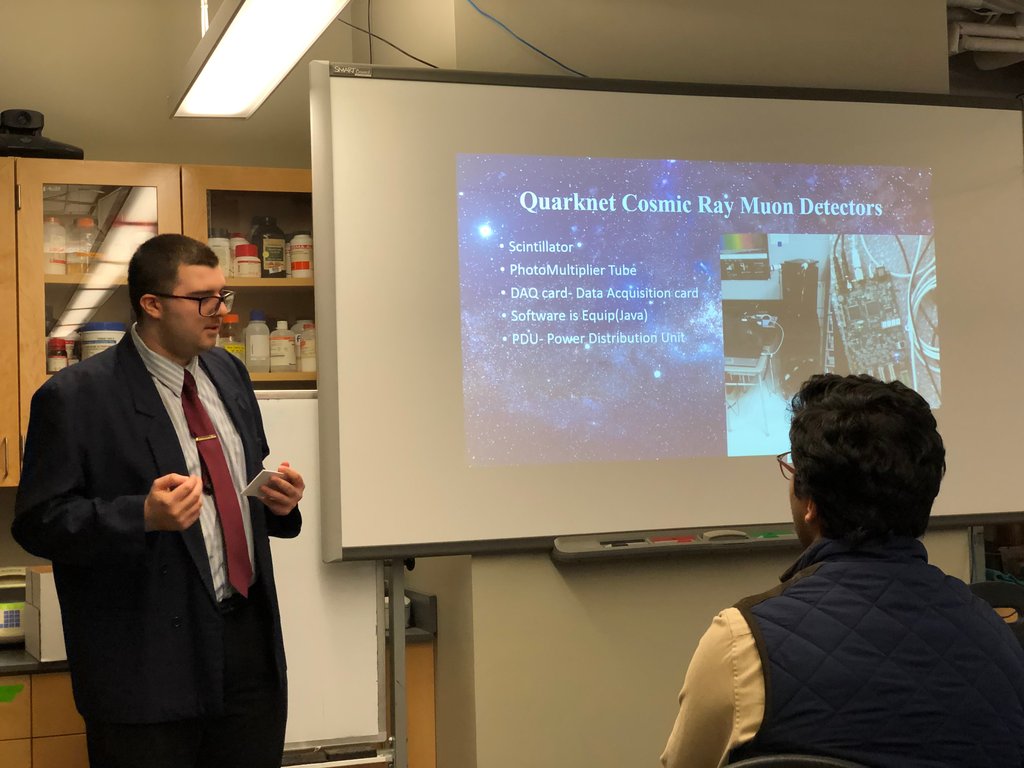
at the School for Science and Math at Vanderbilt. |
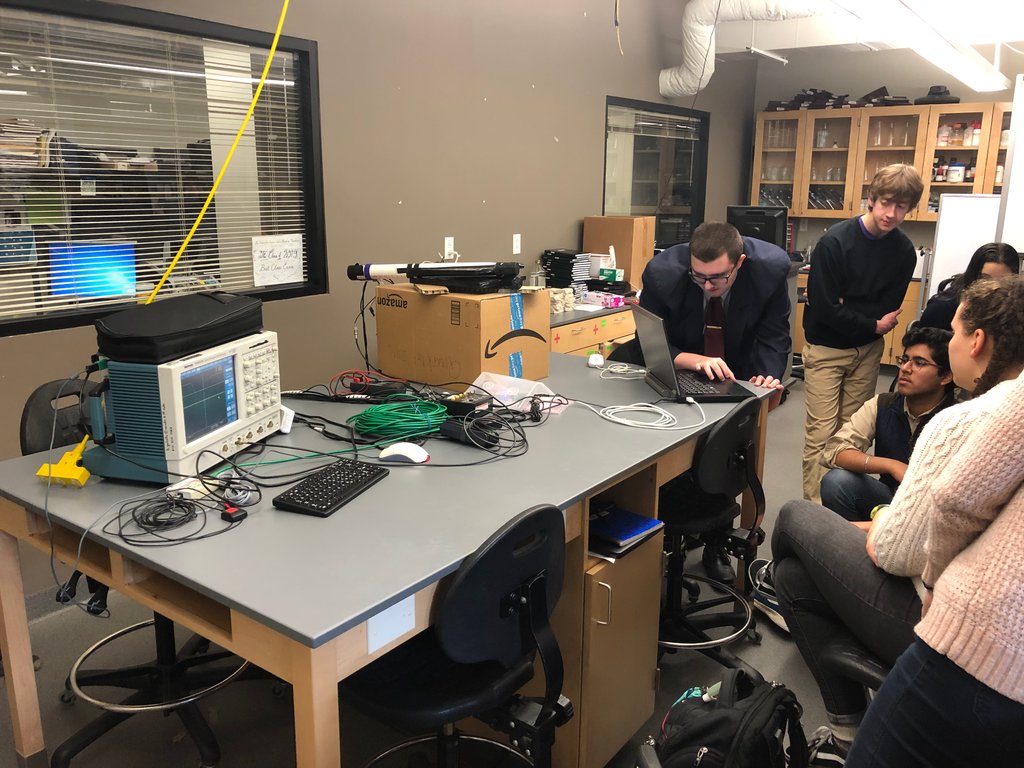
|
Summer Workshop 22-26 June 2020
The main activity of the Vanderbilt QuarkNet Group is hosting the five day workshop for current group members and new science teachers. Due to the ongoing pandemic, the workshop was completely online using Zoom. This worked reasonably well, though it led to my decision to run the meeting half as long...we ran for 3 hours each morning for five days. It was attended by 6 teachers, all current group members from the Metropolitan Nashville Schools, Williamson County Schools, TN, and Warren County Schools, KY. As usual it included talks by Vanderbilt faculty and graduate students, and review of using the CRMDs and the eLab facilities for Cosmic Ray Muons. The main focus this year was the neutrino workshop presented by Ken Cecire, and Shane Wood.
For the first two half-days, we had talks on the Compact Muon Solenoid (CMS), Vanderbilt University is a member of the collaboration, the Large Hadron Collider, and the pulsar timing arrays used for gravitational wave detection. We heard from a new research faculty about his work on the gravitational wave detection experiment LIGO. We heard from a graduate student about her particle physics research on CMS, and she gave a good particle physics (re)introduction. We also had talks about the Relativistic Heavy Ion experiments at the LHC and at RHIC. Vanderiblt physicists belong to Phenix and SPhenix at RHIC and the CMS at the LHC.
On Wednesday morning we focused our efforts on using the Cosmic Ray Muon Detectors and understanding more fo the flow of energy from incoming muon to signal out of the DAQ. Since this was all online, we setup several laptops and cameras in the physics lab containing the two running detectors. From the multiple views, the teachers could see over my shoulder, see the laptop running the detector, and see my face. The attempt was made to record the exercise, but failed as the Zoom presentation switched to my phone used as a portable mic and had no video, so audio but no video was recorded. We went through the hardware by following the energy from the charged muon hitting the scintillator paddle and that energy lost being transformed in the different steps of the detector: lost energy excites photons from the organic dye in the plastic, the light hits a photocathode creating electrons, which hit a set of dynode-electrodes that amplify the electron about 3.3 fold per incoming electron at each dynode, etc, etc. We put an oscilloscope on the output of the photomultiplier tube (or the input to the DAQ card) and stored those triangular voltage vs time waveforms for further analysis. The threshhold could be demonstrated by looking at all waveforms, and seeing some with smaller than 300 mV amplitudes---likely electrical noise but possible low energy muon. The new data and previously saved data was analyzed offline and by hand to see what might be better to correlate with the energy deposited in the plastic by the muon: pulse height, pulse width (time-over-threshhold, TOT), or area under the curve. So the teachers took a few of these triangles, and estimated these numbers. There was a good discusion about the units, mV, ns, or mV*ns, and how none of those is obviously energy. Without a solid conclusion, we suggested that the electrical energy could be found by considering the 50 Ohms in the circuit, V^2/R for power and intergrated in time to find the energy.
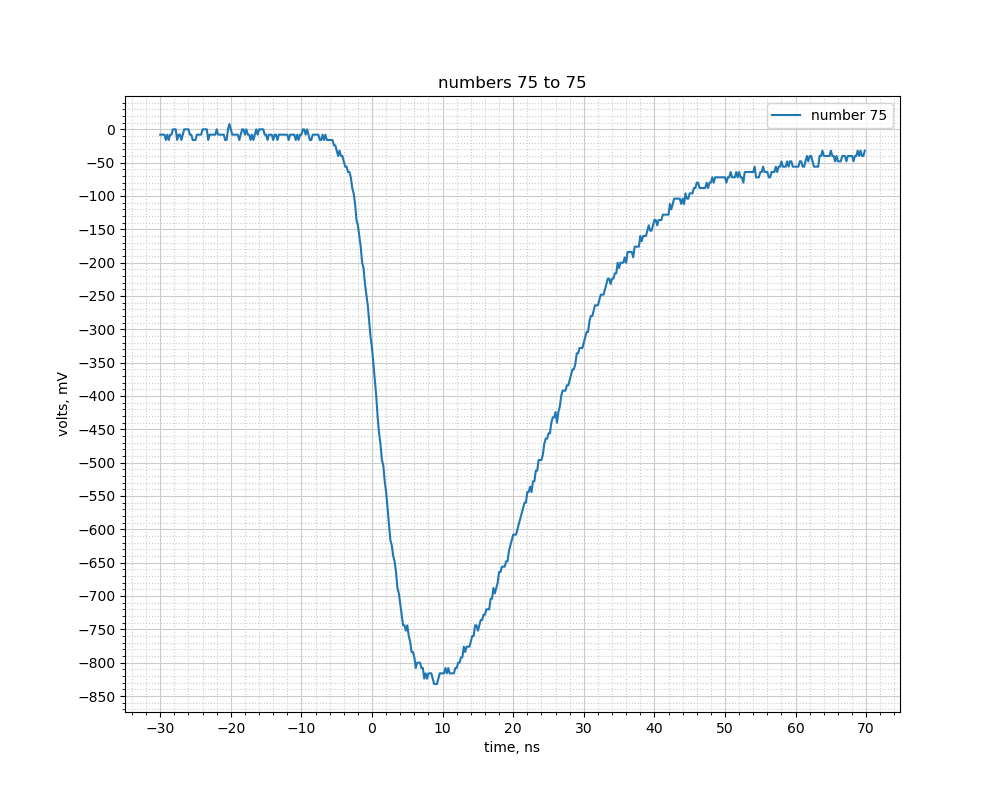
Ken Cecire and Shane Wood (with Spencer Pasero at times) presented the neutrino workshop on Thursday morning and much of Friday morning, at https://quarknet.org/content/virtual-neutrino-workshop-vanderbilt . The decision to focus on neturinos came from my thoughts that they are bizarre and interesting members of the Standard Model of Particle Physics, that my teachers do not hear much about them, and that the US Particle Physics program has focused on neutrinos for domestic experiments. We followed the execellent agenda in the link above which included history of neutrinos, missing momentum in interactions, retrieving data from Minerva, and general discussions of neutrinos. We covered from the invention of neutrinos by Wolfgang Pauli to solve certain energy and momentum non-conserving reactions that had been measured---I gather he was not proud of the invention, at first. And learned to look at the Minerva events and select appropriate ones to look for missing (energy) momentum, and calculate that missing momentum. Along the way, we had several videos assigned including one to (re)visit the Heisenberg Uncertainty Principle. I think this was well-received by the cohort.
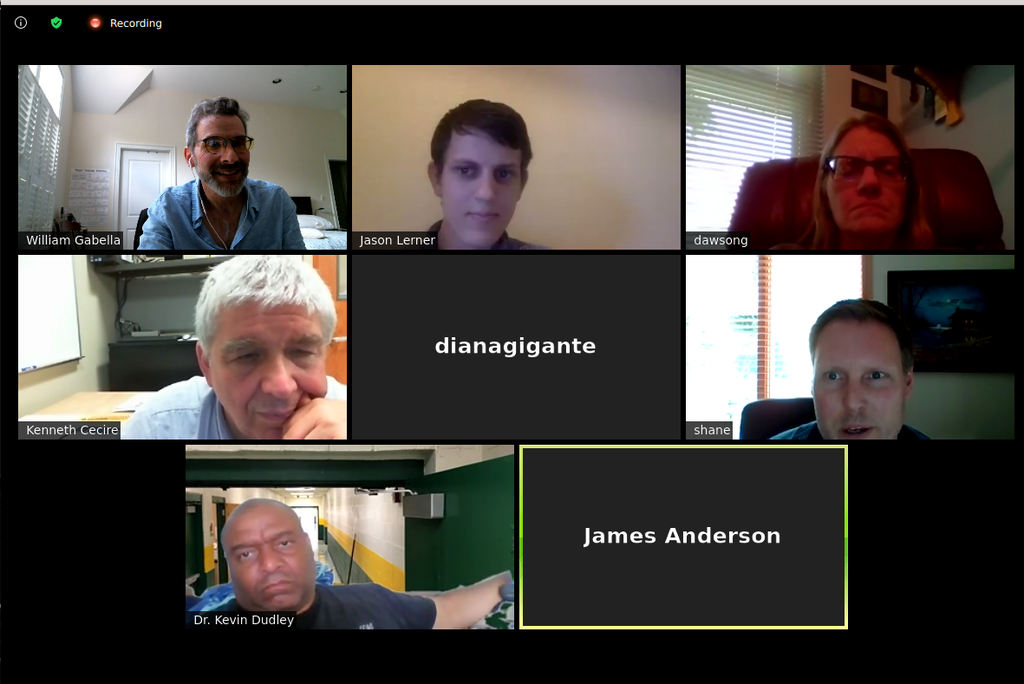
|
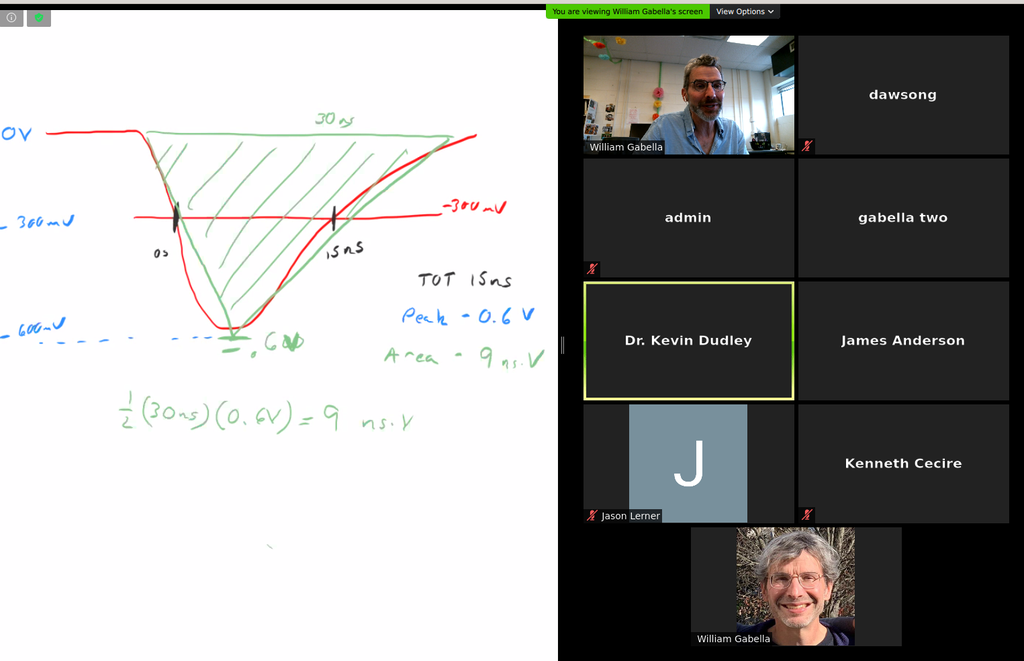
|
In the process with my teachers of trying to find other meeting times and formats, if in person or online. Hope to have a couple more meetings with academic year, likely one day meetings, split between days.
Budget
Because most of out budget is the teacher stipends for the 5 full-day workshop, with a 5 half-day workshop (half the stipend was paid) and with fewer teachers because of issues around the pandemic mostly, we paid out very little of our budget, about 31%. We were given permission to extend out budgets and declare the spending as needed with QuarkNet. That is very helpful.
Links of Interest
(New-ish) GitHub page https://github.com/gabella/VandyQuarkNet/tree/master/quarknet2020
Local web page http://www.hep.vanderbilt.edu/~gabellwe/qnweb
Facebook group page https://www.facebook.com/groups/682323215235912/
Vanderbilt QuarkNet Page (drupal, i.e. here) /group/vanderbilt-university-quarknet-center
[Written and edited by Bill Gabella 20201006]
